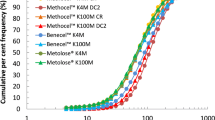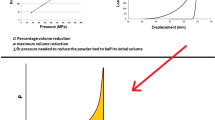Abstract
A work has been done to study the effects of material properties and compression speed on microbial survival and tensile strength in diclofenac tablet formulations. Tablets were produced from three formulations containing diclofenac and different excipients (DC, DL and DDCP). Two types of machines (Hydraulic hand press and single punch press), which compress the tablets at different speeds, were used. The compression properties of the tablets were analyzed using Heckel and Kawakita equations. A 3-dimensional plot was produced to determine the relationship between the tensile strength, compression speed and percentage survival of Bacillus subtilis in the diclofenac tablets. The mode of consolidation of diclofenac was found to depends on the excipient used in the formulation. DC deformed mainly by plastic flow with the lowest Py and Pk values. DL deformed plastically at the initial stage, followed by fragmentation at the later stage of compression, whereas DDCP deformed mainly by fragmentation with the highest Py and Pk values. The ranking of the percentage survival of B. subtilis in the formulations was DDCP > DL > DC, whereas the ranking of the tensile strength of the tablets was DDCP > DL > DC. Tablets produced on a hydraulic hand press with a lower compression speed had a lower percentage survival of microbial contaminants than those produced on a single punch press, which compressed the tablets at a much higher speed. The mode of consolidation of the materials and the speed at which tablet compression is carried out have effects on both the tensile strength of the tablets and the extent of destruction of microbial contaminants in diclofenac tablet formulations.



Similar content being viewed by others
References
Adams, M.J., M.A. Mullier, and J.P.K. Seville. 1994. Agglomerate strength measurement using a uniaxial confined compression test. Powder Technology 78: 5–13.
Alander, E.M., M.S. Uusi-Penttila, and A.C. Rasmuson. 2003. Characterization of paracetamol agglomerates by image analysis and strength measurement. Powder Technology 130: 298–306.
Alebiowu, G., and O.A. Itiola. 2001. Effects of natural and pregelatinized sorghum, plantain and corn starch binders on the compressional characteristics of a paracetamol tablet formulation. Pharmaceutical Technology (Suppl. Ed: Drug Delivery): 26–30.
Armstrong, N.A., and I.P. Palfery. 1989. The effect of machine speed on the consolidation of four directly compressible diluents. Journal of Pharmacy and Pharmacology 41: 149–151.
Ayorinde, J.O., O.A. Odeku, and O.A. Itiola. 2005. The survival of Bacillus subtilis spores in dicalcium phosphate, lactose and corn starch, and their binary mixtures during tabletting. Pharmaceutical Technology 29(12): 56–64.
Bandyopadhyay, R., and J.W. Grant. 2002. Plasticity and slip system of plate-shaped crystals of l- lysine monohydrochloride dihydrate. Pharmaceutical Research 19: 491–496.
Banker, G.S., and N.R. Anderson. 1986. Tablets. In The theory and practice of industrial pharmacy, 3rd ed, ed. L. Lachman, H.A. Lieberman, and J.L. Kanig, 301–303. Philadelphia: Lea and Febiger.
Bashaiwoldu, A.B.B., F. Podczeck, and M. Newton. 2004. A study on the effect of drying techniques on the mechanical properties of pellets and compacted pellets. European Journal of Pharmaceutical Sciences 21: 119–129.
Cook, G.D., and M.P. Summer. 1990. Effects of compression speed on the tensile strength of tablets of binary mixtures containing Aspirin. Journal of Pharmacy and Pharmacology 42: 462–467.
Duncan-Hewitt, W.C., and G.C. Weatherly. 1990. Modelling the uniaxial compaction of pharmaceutical powders using the mechanical properties of single crystals. I: ductile materials. Journal of Pharmaceutical Sciences 79: 147–152.
Fassihi, A.R., and M.S. Parker. 1977. The effects of processing factors upon the microbial content of tablets. Journal of Applied Bacteriology 43: XVII.
Fell, J.T., and J.M. Newton. 1970. Determination of tablet strength by diametral compression test. Journal of Pharmaceutical Sciences 59: 688–691.
Fichtner. F. 2007. Identification and variation of some functionality related characteristics of pharmaceutically relevant solid materials and their effects on product performance. Ph.D dissertation, Faculty of Pharmacy, Uppsala University.
Georget, D.M.R., R. Parker, and A.C. Smith. 1994. A study of the effect of water content on the compaction behaviour of breakfast cereal flakes. Powder Technology 81: 189–195.
Heckel, R.W. 1961a. An analysis of powder compaction behaviour. Transactions of the Metallurgical Society of AIME 221: 1001–1008.
Heckel, R.W. 1961b. Density-pressure relationships in powder compaction. Transactions of the Metallurgical Society of AIME 221: 671–675.
Hersey, J.A., and J.E. Rees. 1971. Deformation of particles during Briquetting. Nature 230: 96.
Itiola, O.A., and N. Pilpel. 1986. Studies on metronidazole tablet formulations. Journal of Pharmacy and Pharmacology 38: 81–86.
Itiola, O.A., and N. Pilpel. 1991. Formulation effects on the mechanical properties of metronidazole tablets. Journal of Pharmacy and Pharmacology 43: 145–147.
Kawakita, K., I. Hattori, and M. Kishigami. 1997. Characteristics constants in Kawakita’s compression equations. Journal of Powder and Bulk Solids Technology 1: 3–8.
Marshal, K. 1986. Compression and consolidation of powdered solids. In The theory and practice of industrial pharmacy, 3rd ed, ed. H.A. Lachman, and J.L. Kanig, 66–100. Philadelphia: Lea and Febiger.
Paronen, P., and M. Juslin. 1983. Compressional characteristics of four starches. Journal of Pharmacy and Pharmacology 35: 627–635.
Plumpton, E.J., P. Gilbert, and J.T. Fell. 1986. Effects of spatial distribution of contaminating microorganisms within tablet formulation on subsequent inactivation through compaction. International Journal of Pharmaceutics 30: 237–240.
Shivanand, P., and O.L. Sprockel. 1991. Compaction behaviour of cellulose polymers. Powder Technology 69: 177–184.
Sonnergaard, J.M. 1999. A critical evaluation of the Heckel equation. International Journal of Pharmaceutics 193: 63–71.
Sujja-areevath, J., D.L. Munday, P.J. Cox, and K.A. Khan. 1996. Release characteristics of diclofenac sodium from encapsulated natural gum mini-matrix formulations. International Journal of Pharmaceutics 139: 53–62.
Sun, C., and D.J.W. Grant. 2001. Effects of initial particle size on the tableting properties of lysine monohydrochloride dihydrate powder. International Journal of Pharmaceutics 215: 221–228.
Zhang, Y., Y. Law, and S. Physical. 2003. Properties and compact analysis of commonly used direct compression binders. http://www.aapspharmscitech.org/view.asp?art=pt040462. Accessed on 10/07/08.
Author information
Authors and Affiliations
Corresponding author
Rights and permissions
About this article
Cite this article
Ayorinde, J.O., Itiola, O.A. & Odeniyi, M.A. Effects of material properties and speed of compression on microbial survival and tensile strength in diclofenac tablet formulations. Arch. Pharm. Res. 36, 273–281 (2013). https://doi.org/10.1007/s12272-013-0027-4
Received:
Accepted:
Published:
Issue Date:
DOI: https://doi.org/10.1007/s12272-013-0027-4




